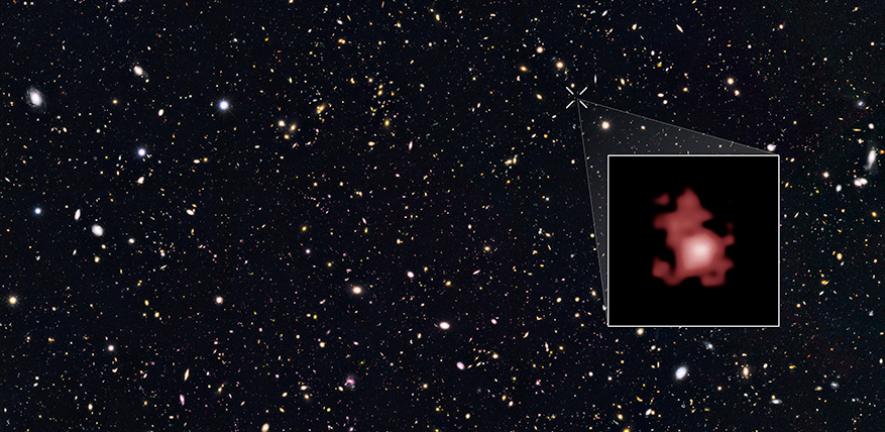This is the Oldest Black Hole Ever Seen
By Carolyn Collins Petersen
There’s an incredibly ancient black hole out there that’s challenging astronomers to explain how it could exist only 400 million years after the Big Bang. It’s at the heart of a galaxy called GN-z11. Astronomers using JWST saw evidence of it gobbling up that galaxy, which is one way a black hole can grow.
In JWST observations, GN-z11 appears to be about 13.4 billion light-years away and is about 100 times smaller than the Milky Way Galaxy. Yet, it has a very bright nucleus, which tells us there’s a black hole at its heart. An accretion disk surrounds the black hole, and it feeds material into the hungry black hole. The motion of the material in the disk heats it, causing it to glow in ultraviolet light. That’s what we see as the active galactic nucleus.

A team of astronomers, led by Cambridge University professor Roberto Maiolino, used the JWST observations to study the motions of material in the galaxy. Finding a black hole like this early in cosmic history is a giant leap forward, he said. “It’s very early in the Universe to see a black hole this massive, so we’ve got to consider other ways they might form,” said Maiolino. “Very early galaxies were extremely gas-rich, so they would have been like a buffet for black holes.”
What Does GN-z11 Tell Us About Black Holes in the Early Universe?
No one is quite sure exactly when the first black holes began to form in the early Universe. If you look at standard models about their creation, it looks like they take a while to get started. Supermassive black holes—like the ones in the hearts of galaxies—could get started as stellar-mass black holes that continue to accrete matter. If that’s how this one in GN-z11 got started, it would have been born when a supermassive star died. Then, somehow it grew to be 6 million times the mass of the Sun. But, there’s a gotcha. It would take nearly a billion years to accumulate that kind of mass. JWST observations show this black hole at a time when the Universe wasn’t even a billion years old. So, something doesn’t add up and perhaps early black holes grew faster than astronomers suspect.
Maybe there’s another way for a black hole to grow that fast. The hint lies in its enormous appetite. Very early galaxies like this one have a lot of material to form stars. However, that also provides food for black holes. As it turns out, GN-z11’s black hole is devouring matter much faster than other black holes do in their galaxies in more modern times. That’s great for the growth of the black hole, but not so great if the galaxy wants to make more stars.

The hungry black hole is actually harming GN-z11. Since it’s consuming a lot of gas, it pushes the gas away in an ultra-fast wind. That stops the process of star formation. Since stars are what galaxies produce, the black hole’s gobbling can actually “kill off” the galaxy. The bad news (at least for the black hole) is that its appetite for gas will spell its doom as it runs out of material to eat.
Going Back to the Beginning
Ultimately, astronomers want to see the “seeds” of the earliest supermassive black holes in galaxies. These seeds likely formed very early in cosmic time, perhaps no later than 200 million years after the Big Bang. The first galaxies assembled fairly quickly and harbored very massive stars that lived perhaps only a few million years. Then, they exploded as supernovae and probably left behind the first stellar-mass black holes. Some have suggested that dark matter helped form early black holes by forcing matter in dense regions to collapse.

However, they formed, black holes in early galaxies got swept up in early galactic mergers. Those seeds merged, too, creating ever more massive black holes. That’s probably why astronomers suspect that supermassive black holes grew by accretion, but not just with each other. They also grew by accretion of material inside their gas-rich galaxies, as GN-z11 seems to show.
Future observations using JWST (and future telescopes) should uncover evidence of those black hole “seeds”. That means GN-z11 may not be the oldest black hole for long. Studying black hole seeds should give Maiolino and other astronomers more clues to unravel the story of how these objects formed not long after the Big Bang.
For More Information
Astronomers Detect Oldest Black Hole Ever Observed
A Small and Vigorous Black Hole in the Early Universe
A Small and Vigorous Black Hole in the Early Universe (arXiv PDF)
The post This is the Oldest Black Hole Ever Seen appeared first on Universe Today.

January 22, 2024 at 11:49PM
via Universe Today read more...

Post a Comment